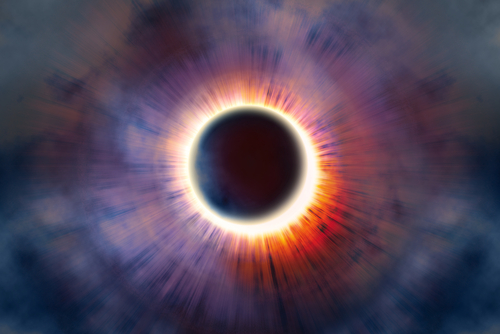Astronomers scrutinized last year’s eclipse. Here’s what they’ve learned
LEESBURG, Va. — Astronomers watching the 2017 solar eclipse from the ground and from the air witnessed new, tantalizing features of the sun’s outer atmosphere.
Three teams have recently presented their first science results from the Great American Eclipse. Combined, the findings could help disentangle lingering solar puzzles, such as how bursts of plasma leave the sun, why the outer atmosphere, the solar corona, is so well organized and what is the nature of the corona’s magnetic field.
While thousands of eclipse watchers gathered across the country last August armed with special glasses and cameras, solar physicists Adalbert Ding and Shadia Habbal and their colleagues set up a specially designed spectrometer in Mitchell, Ore. (That was one of four sites from which their team monitored the eclipse.) The team had used an earlier version of the instrument, which takes in specific wavelengths of light that can trace different coronal temperatures, to watch a solar eclipse in March 2015 from Svalbard, Norway.
In both 2015 and 2017, the scientists observed evidence of relatively cool blobs of gas embedded in hot plasma in the outer corona. (The sun’s surface simmers at about 6000° Celsius, but its corona roasts at millions of degrees — and no one knows why.) Ding, of the Institute for Optics and Atomic Physics in Berlin, and Habbal, of the University of Hawaii in Honolulu, measured wavelengths of light emitted by atoms and charged particles called ions in the corona, as a proxy for the plasma’s heat.
To the researchers’ astonishment, they saw blobs of plasma during both eclipses that had maintained temperatures as low as 20,000° C embedded within material in the corona that was as hot as 3.7 million degrees Celsius, Ding said at the Triennial Earth-Sun Summit on May 23. “We were very surprised,” Ding says. He thinks the cooler material may be trapped within plasma bubbles and can’t get out. “The stunning thing is that they survive.”
The team also measured solar material’s Doppler shift, or the change in wavelength as the material moved toward or away from Earth. The shifts suggested that the scientists had caught a huge bubble of plasma erupting off the sun’s surface and fleeing out into space in 2015 (SN Online: 6/16/17). At the time, they thought seeing such an explosion, called a coronal mass ejection, was just luck.
If so, their luck held for the 2017 eclipse. The researchers haven’t finished processing all of their data yet, but preliminary results showed uncharged hydrogen and helium atoms fleeing the sun as far out as 3.5 solar radii from the edge of the sun’s bright disk, at speeds of about 600 kilometers per second.
In another talk at the meeting, solar physicist Amir Caspi of the Southwest Research Institute in Boulder, Colo., presented results from a different vantage point: a WB-57F aircraft flying at about 15 kilometers in altitude.
Caspi’s team was trying to see signs of magnetic waves called Alfvén waves rippling through the outer corona. Simulations of the plasma in the corona “lead you to this Velcro-looking thing, a tangled snarled mess,” Caspi said. “In fact, that’s not what we see.” Alfvén waves could smooth out the snarls, which could help explain why the material there is so neatly organized (SN Online: 8/17/17). What’s more, the waves may contribute to the mysterious coronal heating. So Caspi’s colleagues flew telescopes on a pair of NASA’s high-altitude aircraft during the eclipse to look for these waves.
The results were mixed, Caspi admits, in part because the telescopes were not designed for this type of science. NASA originally commissioned them to monitor shuttle launches for issues after the space shuttle Columbia disaster in 2003 (SN: 2/8/03, p. 83).
“Our mission was the first attempt to use them for astronomy,” Caspi says.
The telescopes saw some motion in the corona that could have been waves — or could have been jitter from the planes’ motion. “They’re tantalizing, they’re definitely not random,” Caspi said. “But we don’t know yet whether this is an artifact of the corrections we had to make, or if this is really on the sun.”
The team also captured an image of the corona in infrared wavelengths, which the researchers think is the first image of its kind. Eventually, such infrared measurements could help scientists measure the corona’s magnetic field, which governs most of the corona’s behavior but has never been measured directly (SN Online: 8/16/17).
In another experiment, solar physicist Jenna Samra of Harvard University and her colleagues were on the lookout for certain infrared wavelengths in the corona that were expected to be bright enough to see from the ground.
The team measured five wavelengths, one of which had never been seen before, the team reports in the April 1 Astrophysical Journal Letters. Solar physicist and study coauthor Philip Judge of the High Altitude Observatory in Boulder had predicted in 1998 that those wavelengths, which are especially sensitive to the magnetic field, should be visible in the corona. The results can help plan future observations with the Daniel K. Inouye Solar Telescope, currently under construction in Maui, Hawaii.
Judge and other team members observed the eclipse from Casper, Wyo., and saw some of the same wavelengths (SN Online: 8/21/17), although water in Earth’s atmosphere absorbed some of the light.
Samra, however, observed the eclipse from a plane, a Gulfstream V aircraft at an altitude of 14.3 kilometers. “It was a one-of-a-kind experience. I wouldn’t trade it,” she says. “But in the moment it was terrifying, honestly.”

